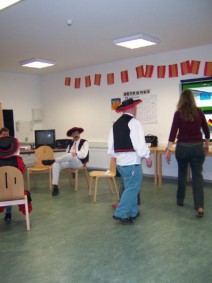LIST OF ARTICLES
|
Teaching a foreign language to adults with learning disabilities
Background:
The clients at Schottener Reha are adults with mental disabilities / disorders of varying degrees. Their experience with “schooling” has been a negative one and resulted in great fear of "school-type” learning. Their self-esteem and self-worth are generally very low; they are convinced that learning a foreign language is “for other people”.
The staff at Schottener Reha are experts in working with disabled people, teaching them social and life skills, using occupational and other forms of therapy. They are highly committed to their challenging daily work which usually doesn’t include “teaching languages” or “raising language awareness”.
A young Spanish intern (participating in a “Voluntary Year of Social Service”) has come to work at the institution for several months.
The ALLEGRO approach:
1) MOTIVATION
a) Participants:
Taster sessions were held to show the prospective (voluntary) participants that the activities in the ALLEGRO group would be quite different from what they had experienced at school. There was no blackboard in the room; music from Spain was played; they were invited to join into a musical game and into a game with balloons involving repeating Spanish words.
After this session an initial group formed immediately and several more participants applied after hearing about the group by word of mouth.
b) Staff:
They were informed that “teaching” a language would be quite different from what their own language learning at school had been like. They would be using new methods, raising their clients’ self-esteem, and helping them to develop new skills and competences.
The staff members’ became interested in this approach and were willing to co-operate. The intern agreed to work with the group.
2) METHODS
a) Physical activities e.g.
movement, dance, games
(awareness raising of “difference” in language; first words)
b) Contextual activities e.g.
i) numbers: rolling dice; playing with balloons
ii) food: going to Spanish restaurant; cooking together (preparing shopping list, buying ingredients)
iii) clothes: ”fashion show” presenting different clothes; cutting clothes from a mail order catalogue and naming them
c) Arts
Participants producing their own learning material e.g.
i) forming objects from papier-mâché and painting them (fruits and colours)
ii) making simple card games (Memory)
d) Cognitive activities
Recognizing some key words in writing (using signs with words in very big letters; “painting” these words)
Memorizing sequences (e.g., months; days of the week)
Answering standard questions (e.g. age; birth date)
3)DEVELOPING ACCESS TO NEW CONCEPTS AND AREAS (unknown or not used when communicating in mother tongue!)
a) social competences e.g. “polite” speech (please, thank you, would you..)
b) better grammar (affecting use of mother tongue!) e.g. using correct articles using correct plurals
4) REALIZING AND RECOGNIZING LIMITATIONS (depending on the severity of the disability)
a) lack of concentration, short attention spans
b) need for constant repetition
c) great problems with making cross references
d) only “learning by doing”
5) REALIZING AND RECOGNIZING OPPORTUNITIES
a) teaching the basics of a language without any “schooling”
(Participants know enough to “survive” in Spain)
b) enhancing and promoting the intellectual, social and emotional development of the participants
c) increasing self-confidence and self-value of participants
d) providing new insights (language awareness) and working methods for staff
|

|
|
Produced by a work group from “Schottener Reha,” at the ALLEGRO partner meeting, Ljubljana 18/06/05
Members:
Heike Becker, Elke Thiele, Camino Gomez
|